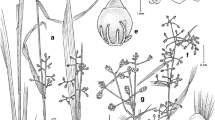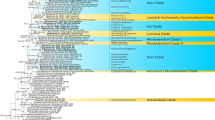Abstract
Three species of Rhytismatales on Berberis were found from Sichuan and Yunnan provinces in China. Two of them were described as new species to science, namely Hypoderma minteri and Lophodermium johnstonii. The third one was a known species, Hypoderma berberidis. The phylogenetic relationships of these species within the Rhytismatales were analyzed based on internal transcriber spacer ribosomal DNA. The results showed that the species of the Rhytismatales on Berberis, unlike most species on pines, were not closely related. Three ITS sequences from GenBank, named there as Lirula macrospora, were used in this study, but were found to be from misidentified sources. A key to species of Rhytismatales on Berberis worldwide is also given.




Similar content being viewed by others
References
Cannon PF, Minter DW (1983) The nomenclatural history and typification of Hypoderma and Lophodermium. Taxon 32:572–583
Chen MM (2002) Forest fungi phytogeography: forest fungi phytogeography of China, North America, and Siberia and international quarantine of tree pathogens. Pacific Mushroom Research and Education Center, Sacramento, 469 pages
Fan L, Lin YR, Wang S, Hou CL (2012) Two species of Lirula on Abies from Yunnan, Southwest China. Mycol Prog 11:279–286. doi:10.1007/s11557-011-0747-0
Gardes M, Bruns TD (1993) ITS primers with enhanced specificity for basidiomycetes application to the identification of mycorrhizae and rusts. Mol Ecol 2:113–118
Hou CL, Piepenbring M (2006) Five new species of Hypoderma (Rhytismatales, Ascomycota) with a key to Hypoderma species known from China. Nova Hedwig 82:91–104
Hou CL, Liu L, Piepenbring M (2007) A new species of Hypoderma and description of H. rubi (Ascomycota) from China. Nova Hedwig 84:487–493
Hou CL, Li L, Piepenbring M (2009) Lophodermium pini-mugonis sp.nov. on needles of Pinus mugo from the Alps based on morphological and molecular data. Mycol Prog 8:39–33. doi:10.1007/s11557-008-0575-z
Huelsenbeck JP, Ronquist F, Nielsen R, Bollback JP (2001) Bayesian inference of phylogeny and its impact on evolutionary biology. Science 294:2310–2314
Johnston PR (1990) Rhytismataceae in New-Zealand 3. The genus Hypoderma. NZ J Bot 28:159–183
Lantz H, Johnston PR, Park D, Minter DW (2011) Molecular phylogeny reveals a core clade of Rhytismatales. Mycologia 103:57–74
Li JL, Su GM, Xiao XH (1997) Study on the species resources and distribution laws of the Berberis genus plants in Sichuan province. J Southwest China Normal Univ (Nat Sci) 22:385–391
Lin YR, Xu ZS, Yie GB, Wang SJ (2004) Additional species of Lophodermium Chev. from China I. Mycosystema 23:14–17
Ma ZG, Ma XY, Yang PR (1999) Comprehensive studies on medicinal plants of Berberis in recent 30 years. J Gansu Sci 11:75–78
Ortiz-García S, Gernandt DS, Stone JK, Johnston PR, Chapela IH, Salas-Lizana R, Alvarez-Buylla ER (2003) Phylogenetics of Lophodermium from pines. Mycologia 95:846–859. doi:10.2307/3762013
Powell PE (1974) Taxonomic studies in the genus Hypoderma (Rhytismataceae) [doctoral dissertation]. Cornell University, Ithaca, p 116
Rambaut A (2000) Estimating the rate of molecular evolution: incorporating non-contemporaneous sequences into maximum likelihood phylogenies. Bioinformatics 16:395–399
Ronquist F, Huelsenbeck JP (2003) MrBayes 3: Bayesian phylogenetic inference under mixed models. Bioinformatics 19:1572–1574
Sherwood MA (1980) Taxonomic studies in Phacidiales: the genus Coccomyces (Rhytismataceae). Occ Pap Farlow Herb Crypt Bot 15:1–120
Swofford DL (1998) PAUP*: phylogenetic analysis using parsimony (and other methods). Sinauerm, Sunderland
Tehon LR (1935) A monographic rearrangement of Lophodermium. Biol Monogr 13:1–151
Thompson JD, Gibson TJ, Plewniak F, Jeanmougin F, Higgins DG (1997) The CLUSTAL_X windows interface: flexible strategies for multiple sequence alignment aided by quality analysis tools. Nucleic Acids Res 25:4876–4882
Wang SJ, Liu HY, Chen L, Liu YB, Lin YR (2007) Two new species of Rhytismataceae. Mycosystema 26(2):161–164
White TJ, Bruns T, Lee S, Taylor J (1990) Amplification and direct sequencing of fungal ribosomal RNA genes for phylogenetics. In: Innis MA, Gelfand DH, Sninsky JJ, White TJ (eds) PCR protocols. A guide to methods and applications. Academic, New York, pp 315–322
Xu SH, He MS, Liu XP (2003) Berberine contents on B. triacanthophora. J Chin Med Mater 26:183–184
Acknowledgments
This study was supported by NSFC (No.30770006 and 31170019) and PHR (KZ201110028036).
Author information
Authors and Affiliations
Corresponding author
Rights and permissions
About this article
Cite this article
Wang, S., Taylor, J.E. & Hou, CL. Species of Rhytismatales on Berberis from China. Mycol Progress 12, 629–635 (2013). https://doi.org/10.1007/s11557-012-0868-0
Received:
Revised:
Accepted:
Published:
Issue Date:
DOI: https://doi.org/10.1007/s11557-012-0868-0




